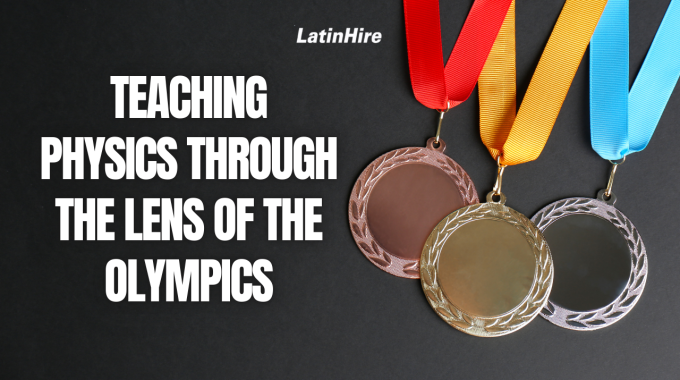Quantum numbers form the foundation for understanding atomic structure and electron behavior. These numbers describe…

Teaching Physics Through the Lens of the Olympics
Have you ever thought, “What’s the physics behind sports?” With all the motion, jumps, and physical exertion involved, sports is one of the best real-world examples to introduce physics concepts.
As we’re halfway through the Paris Olympic Games 2024, beyond the excitement of intercontinental competition, these Olympic sports offer a unique and engaging way to explore fundamental physics topics.
By taking a look at the mechanics behind Olympic events, we can bring physics to life in the classroom and make learning more dynamic and relatable.
The Physics of Motion: Track and Field
Running and Sprinting
Races during the Olympics is a classic example of Newton’s laws of motion. Newton’s First Law says that an object at rest stays at rest unless acted upon by a force. Sprinters demonstrate this law as they accelerate from a standstill position, requiring a net force to overcome the initial inertia.
Newton’s Second Law states that Force = Mass x Acceleration, so the greater the force the athlete pushes forward with, the greater the acceleration.
Newton’s third law of motion states that for every action, there is an equal and opposite reaction. As athletes push against the track, the track also exerts the same amount of force on the athletes, propelling them forward.
Long Jump and High Jump
Both of these Olympic events are perfect examples of projectile motion. In long jump, athletes convert horizontal speed into vertical lift, with their trajectory following a parabolic path.
The high jump, on the other hand, involves understanding the center of mass and the Fosbury Flop technique, where the athletes arch their bodies over the bar, optimizing their center of mass to achieve greater heights. As the athletes near the bar, they bend their backs at the peak, allowing their bodies to clear the bar while their center of mass travels as much as 20 cm underneath the bar.

The Physics of Forces: Gymnastics
Balance Beam
Gymnasts on the balance beam provide a clear demonstration of torque and rotational equilibrium. The narrow beam requires precise control of their center of gravity to avoid tipping over. By manipulating their body position, gymnasts manage the torques to maintain balance. When you notice a gymnast wobbling on the balance beam, that shows that their center of gravity has shifted.
Fun fact: In the past, balance beams were made of plain, polished wood, which didn’t give much cushion for the gymnast to land on. They were then covered in basketball-like material, which made them very slippery! Eventually balance beams were covered in leather and suede, which increased the coefficient of friction between the beam and the gymnast, making it much easier to stick a landing after a flip!
Vault
The vault event showcases the conversion of kinetic energy into potential energy and back again. As gymnasts run towards the vault, their kinetic energy increases. Upon hitting the springboard and vault, this energy is momentarily converted into potential energy, which then propels them into impressive flips and twists.
When gymnasts spin in the air, they are demonstrating angular momentum. As they retract their arms and legs, their moment of inertia decreases, but their angular velocity increases to compensate, preserving their angular momentum.

The Physics of Fluid Dynamics: Water Sports
Swimming
Swimming events offer a practical application of fluid dynamics. Swimmers must minimize drag forces acting against them while maximizing propulsion. The streamline position, where a swimmer reduces resistance by aligning their body, illustrates the principles of fluid dynamics and Bernoulli’s principle. Swimmers also leverage Newton’s Third Law by pushing water backwards to move forward efficiently.
There is also the idea of buoyancy in water sports. In order to float in water, an object must be less dense than water, allowing a buoyancy force to lift the object. This relates to Archimedes’ principle, which states that any object suspended in fluid is acted upon by an upward buoyant force equal to the weight of the fluid that is displaced by the object.

Surfing
Surfing is a relatively new Olympic sport. It replies on a delicate balance of buoyancy and hydrodynamics to counteract gravity in order to keep the board and rider afloat. Gravity pulls the surfboard down while buoyancy pushes it up. Which force is greater depends on the density and material of the surfboard. Today’s surfboards are much lighter and less dense in material than in the past, allowing them to float much easier.
The Physics of Energy: Weightlifting
Weightlifting events highlight the concepts of work, energy, and power. Lifters convert chemical energy stored in their muscles into mechanical energy to lift heavy weights. The work done by a weightlifter (force applied over a distance) and the power (rate of doing work) are key physics principles that determine their success.
Also, gravity is constantly pulling down on the bar, so the weightlifter must produce a force up against the bar that is greater than the force of gravity to push the bar upwards and to keep it from falling down towards the ground.

If you are a physics teacher, consider using Olympic events to introduce physics concepts! Using real life examples is an effective way to teach complex ideas. What other physics concepts can you identify in Olympic sports? Share your ideas in the comments below!



